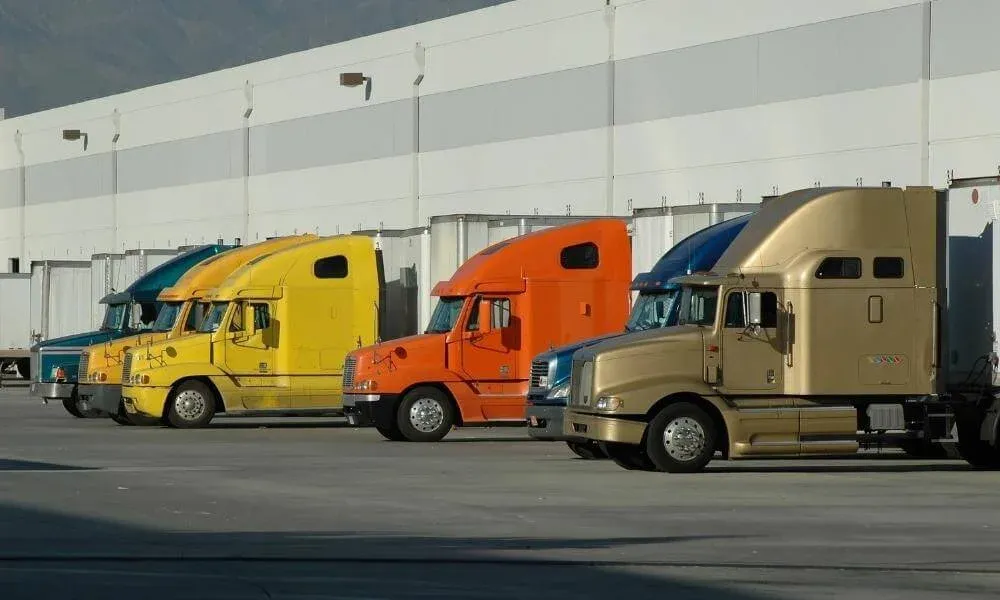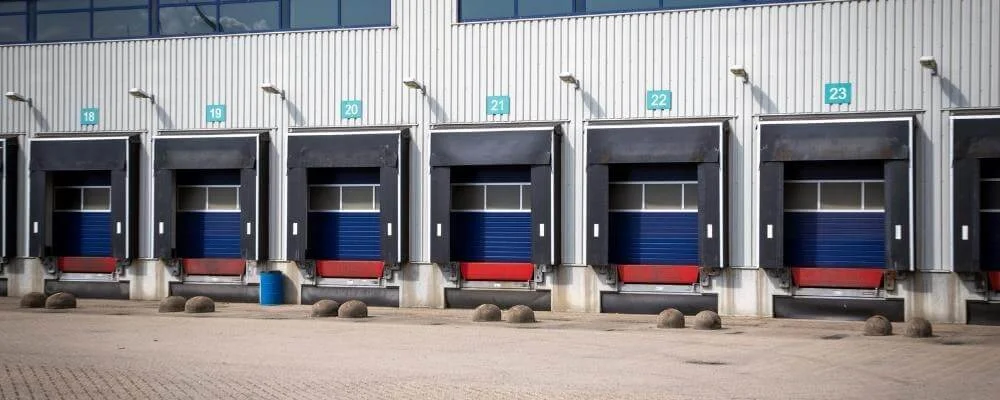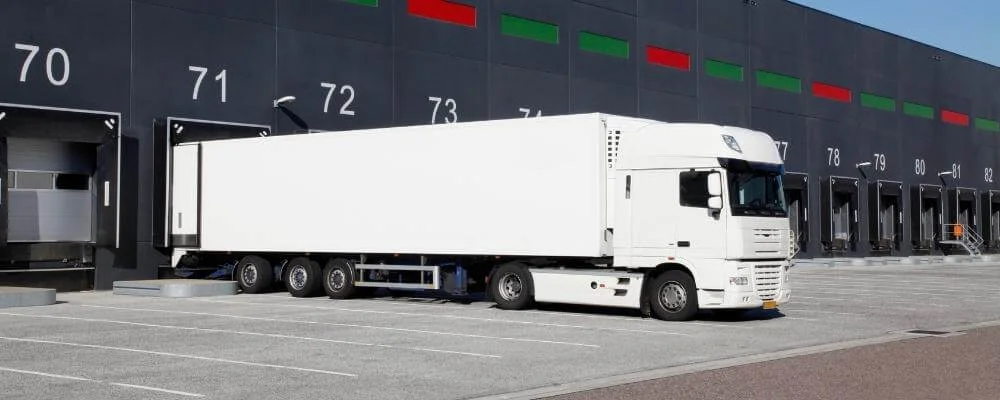Loading Dock Safety Hazards and Safe Work Procedure

Loading docks are busy areas where trucks, trailers, pedestrians, lifting devices, and other equipment frequently move. Serious or fatal injuries can be sustained from loading dock hazards such as unsecured vehicles moving on the dock, lift trucks tip-over or falling, and pedestrian collisions with lift trucks, falling loads, or tractor-trailers. Therefore, it is essential to identify common causes of loading dock injuries and how to prevent typical hazards that may be present in the dock area.
When we think of safety in the transportation industry, we automatically envision Ontario’s roads, streets, and highways. However, safety on loading docks is also important. Loading docks can be dangerous places if not properly supervised. Employees working in and around loading docks must know the hazards and follow safe work procedures. In this blog post, we will discuss the hazards associated with loading docks and some safe work procedures that should be followed to minimize the risk of injury.
Loading Dock Hazards
Loading docks are busy places with vehicles and equipment moving inside and outside the facility. When freight is being moved, time is of the essence. Along with the efficient movement of materials, however, it is important to consider the safety of those working on and around the loading dock.
Although most docks or shipping areas are laid out and equipped to move freight safely and efficiently, they are also a place where a misstep or an inattentive moment can result in an injury. Always watch for hazards, even if you are not involved in the loading or unloading.
A review of incidents over the last decade in Ontario shows that workers can suffer serious injuries and fatalities at indoor and outdoor shipping and receiving areas. Fatalities have resulted from workers being:
- Pinned between loading dock and truck or trailer
- Pinned between truck and trailer
- Struck by or run over by a truck
- Struck by falling items that were not secured
- Struck by a falling dock plate.
- Uneven dock surfaces
- Dock levelers that are not properly maintained
- Improperly secured loads
- Poor lighting
- Inadequate ventilation
Workers in shipping and receiving areas can be exposed to hazards involving external trucking firms contracted to deliver and carry loads. If truck drivers are unfamiliar with the workplace, it can put everyone at risk.
For example, there may be:
- Different measures and procedures for securing vehicles against accidental movement
- Unique features involving the yard layout
- Specialized dock leveling and dock locking systems
- Lifting devices that drivers may not be trained to use.

Loading Dock Safe Work Procedures
When working on and around loading docks, follow these best practices and procedures:
- Using the proper material handling equipment when working with loading docks is important. This includes using a forklift or pallet jack to move goods and a safety harness when working on the dock. It is also essential to inspect all components before use to ensure safety.
- Always use equipment that you are authorized and trained to operate. Follow the manufacturer’s manual for instructions, and never exceed the recommended load rating.
- One of the key things to remember when working near a loading dock is to keep out of the way of any moving equipment. This means staying clear of forklifts, pallet jacks, and other machinery. It’s also important not to get “trapped” in an injury. This can happen if you’re in the way of a moving piece of equipment and it suddenly starts moving again. To avoid this, always be aware of your surroundings and ensure you have plenty of space to move around safely.
- Make sure to stay alert for trucks and other traffic, as well as lifting equipment and other cargo. Be especially careful when near fixed objects, dock carts, or cargo being placed into position.
- Block the wheels when loading or unloading a vehicle to prevent it from moving. Use caution when doing this, as the brakes on a vehicle can only do so much to stabilize it.
- One important safety precaution when using loading dock plates is to make sure they are properly secured into position. Failing to do so can lead to accidents and injuries.
Safety Around Tractor Trailers
- When working around tractor-trailers, ensure that the parking brakes are engaged to prevent movement and that the engine is shut off to avoid the buildup of fumes. Fumes from the engine can be dangerous, mainly if a fire occurs.
- To ensure that the tractor and trailer go nowhere during the loading and unloading process, Have the driver turn over their keys; Place a warning sign in front of the tractor cab; Use a “dock lock” or “wheel lock” system and Require truck drivers to remain in a designated area until loading/unloading is complete.
- If using an air ride suspension, remove the air from the system before loading or unloading. This will help improve the trailer’s stability and reduce the chance of damage to the dock’s bumper pads.
- Make provisions to prevent railroad cars from being moved during loading and unloading. Wheel stops, hand brakes, and other recognized controls must be used to prevent movement during loading and unloading.
- This is an important safety step when loading and unloading trailers at the dock. The trailer can easily tip over if you only load or unload from one side. Make sure that both sides are full before beginning the process.
- Make sure both wheels are chocked.
- When using a loading dock, it is important to use jack stands to prevent overbalancing on the dolly legs. This is especially important when using trailers with reefers or pup trailers or when loading heavy materials.
- Check the trailer floor to ensure it is in good condition and can handle the weight of your truck and load.
- Use sand or salt to provide better traction if the dock or trailer floors are slippery.
- Keep pedestrians clear of trailers and generally out of the dock area. If a pedestrian needs to talk to the operator, they should wait to the side of the dock plate out of the lift truck’s path of travel.
- Make sure the dock and trailer have proper lighting. This will ensure you can see what you are doing and avoid accidents.
- To keep the loading dock safe, checking the dock plate each time a vehicle rolls over is essential. If you notice any increase in the space between the trailer and the dock, notify your supervisor immediately. This could indicate a safety issue that needs to be addressed.
- Leaving a fuel-powered vehicle running on a trailer can lead to dangerous situations. For example, if the vehicle’s exhaust system leaks, deadly carbon monoxide gas can build up in the trailer. Always turn off fuel-powered vehicles before leaving them on a trailer to avoid these dangers.
- Stop and look over both shoulders when backing off a trailer to ensure the way is clear. You should also use your mirrors to check what is happening behind you. If there is any obstruction in your path, wait until it is cleared before proceeding.
- When stacking materials on a trailer, ensure your lift truck has sufficient “free lift” to allow this without damage to the trailer roof.
Safety Around Lift Trucks
When working near the various types of lift trucks at loading docks, follow these best practices:
- Power lift truck operators must be competent workers to safely operate the vehicles. This means that they must have the necessary training, knowledge, and skills to do so. Employers should ensure that operators have the appropriate certification or licensing, as well as proper on-the-job training. Operators who are not competent workers can cause severe injuries to themselves and others.
- Maintaining lift trucks in a safe condition is critical for ensuring the safety of workers. lift trucks must be inspected regularly to ensure that all safety features are operational and that the truck complies with regulatory requirements. If any defects or issues are found, they must be corrected immediately.
- Include elements of an effective powered lift truck safety program in training and safety meetings.
- When working in a warehouse, it is important to always wear suitable clothing and safety shoes or boots. This will help to protect you from potential hazards that may be present in the warehouse environment.
- When getting in and out of the cab, always use 3-point contact. That means either two feet and one hand or two hands and one foot on the vehicle at all times. This will help you keep your balance and avoid falling.
- When working in the warehouse, it’s important to be aware of your surroundings at all times. Look for other workers and vehicles, especially near doorways and at the ends of the aisles. If you see someone or something coming, move out of the way quickly and safely.
- When backing up, always be aware of your surroundings and look in the direction you are traveling. This will help you avoid any potential accidents or obstacles.
Loading Dock Inspections
Loading docks must be well-maintained at all times. Consider these items during regular inspections:
- Make sure that general housekeeping and maintenance practices are followed. This includes sweeping and cleaning the dock area regularly, checking for spills or leaks, and keeping the dock in good repair.
- Ensure that passageways and stairs are free of obstructions so that employees can move safely around the loading dock.
- Mirrors are installed at any blind corners to help ensure that the entire dock is being inspected.
- To keep the loading dock area safe for employees and equipment, it is important to keep it clear of ice or snow during inclement weather. This can be done through regular maintenance and inspections.
- Inspect the loading dock for materials that have been stacked too high. Ensure that the items are not stacked too high and are properly stacked so they will not tip over.
- Manual lifting is avoided or reduced when possible.
- Inspect all equipment to ensure they are in proper working condition. This includes inspecting the equipment for damage, checking for proper operation, and verifying that safety features function properly.
- Potholes and loose pavement can be safety hazards for employees and equipment. It is important to keep the dock area free of these hazards through regular inspections.
- Warning signs are placed in areas where required.
- Truck engines are turned off when not needed.
- Combustible materials are properly stored.
- Spill kits are available and maintained.
- All staff and drivers are aware of the appropriate procedures and safety rules.

Keys To Loading Dock Safety
Working on loading docks presents a variety of hazards for employees and poses special safety issues. Workers must be careful about what they are doing and always be aware of other workers around them—particularly co-workers using forklifts and other material-handling equipment.
Be On The Lookout For These Loading Dock Hazards:
- Slipping or tripping on wet, oily, or broken floor surfaces
- Falling off dock edges
- Injuries from falls or unsecured dock plates
- Injuries resulting from unchocked trailer wheels
- Illness or unconsciousness from inhaling carbon monoxide from trucks
- Back injuries from improper lifting and carrying
- Injuries from careless behavior around forklifts and other vehicles.
Keep Floors Clean, Dry, And In Good Condition
- Place containers, packaging, tools, and other materials safely out of walking and driving areas.
- Clean up and properly dispose of trash.
- Place oily rags or other combustible trash in closed containers.
- Clean up any spills immediately. Alert trained responders to major spills. Follow safety data sheets for cleaning up a chemical spill.
- Watch out for dripping rain, melting ice, etc.
- Report any cracked or broken concrete or other flooring.
Keep Dock Plates In Place
- When loading or unloading a truck, always check the dock plate load capacity to ensure it can handle your specific load. Overloading a dock plate can damage the equipment and create a safety hazard.
- To secure your movable dock boards, ensure they are positioned correctly. Then, use something to secure them so they don’t slip. This can be anything from a piece of rope to a bungee cord. Whatever you use, just make sure it is tight enough that the boards won’t move around.
- It’s important to slide dock plates into position rather than drop them. Dropping the plates could damage them and make it more difficult to get a good seal. Sliding the plates into position may take longer, but it will help seal your dock properly.
Take Precautions To Prevent Falls
- Walking, not running, is important if you’re on a loading dock. Running can cause you to slip and fall, leading to serious injuries. Plus, walking helps to prevent accidents by giving you more time to react if something unexpected happens.
- You might think pushing someone around is funny, but it’s not. It can be dangerous and cause serious injury. Even if you don’t mean to hurt anyone, accidents can happen. So, please be careful and don’t push people around.
- Edges of loading docks can be extremely dangerous. You could easily slip and fall off the edge without being careful. This could result in serious injury or even death. Always take caution when near the edges of loading docks, and never attempt to climb on or jump off them.
- Always use the loading dock when loading or unloading goods from a truck. Do not jump on or off the dock, leading to serious injury. Use caution around the loading dock area, and always be aware of your surroundings.
- Wear sturdy shoes with nonskid soles that support both the foot and ankle.
- It’s important to watch where you’re going when loading or unloading a dock. There are a lot of potential hazards, and it’s easy to get injured if you’re not careful.
Work Safely With Trucks And Trailers.
- Before loading or unloading a truck or trailer, it is important to check that the wheels are choked. This will help prevent the vehicle from moving and ensure a safe and efficient operation.
- Make sure drivers turn off their motors to prevent carbon monoxide exposure. Invisible and odorless, carbon monoxide can be fatal.
Load And Unload Correctly To Prevent Injuries
- Use a forklift or dolly to move heavy objects whenever possible instead of lifting them yourself. If you must lift something heavy, ask a coworker for help. Using proper lifting techniques can help prevent injuries.
- No matter how strong you think you are, never try to lift skids and pallets alone. They can be extremely heavy and difficult to maneuver, and trying to do so by yourself is simply asking for an injury. If you need to move something heavy, always ask for help or use a lifting device like a forklift or crane.
- When you lift something heavy, it is important to Bend your knees and keep your back straight. This will help to prevent injury by ensuring that your legs do the work, not your back. By keeping your back straight, you can maintain a good posture and avoid putting unnecessary strain on your spine.
- Wearing snug-fitting gloves can help you get a better grip when lifting, loading, and unloading. This can help prevent accidents and injuries.
- Always load hand trucks with heavy objects on the bottom and weight forward over the axle. This will help prevent tipping and make it easier to control the load.
- Keeping the load balanced and secure when loading or unloading a hand truck. The last thing you want is for your load to topple over and cause damage or injury. To help keep your load stable, ensure the height is at a level you can see over it. This will give you a better view of what you’re dealing with and help you avoid potential hazards.
Be Alert To Other Vehicles, Workers, And Materials.
- When working around forklifts, it is important to stay aware of your surroundings and not distract the operator. Keep safe from the forklift and avoid walking or standing in its path. Never try to ride on a forklift, as this can be very dangerous. If you need to speak with the operator, do so from a safe distance and make sure they are aware of your presence.
- Getting out of the way is important if you hear a forklift horn sounding. Forklifts can be very dangerous, and you don’t want to be in the way when one is moving around.
- Be careful of materials on the dock that could fall or roll. Pay attention to your surroundings and be aware of potential hazards. If you see something unsafe, report it to a supervisor immediately.
- Wear a hard hat, eye protection, and hearing protection when required. This will help protect you from falling or flying objects and noise.
Conclusion
In conclusion, loading docks are essential zones in the transportation industry, bustling with activity, vehicles, and equipment. Their importance for material movement is undeniable. However, the potential hazards associated with them cannot be overlooked. The safety of workers in these areas is paramount, and employers, operators, and pedestrians alike must be educated about potential dangers and how to mitigate them.
Awareness is the first step in prevention. Regular inspections, competent training, correct equipment use, and adherence to safety protocols are essential components of a comprehensive safety plan. While efficiency and speed are often emphasized in shipping and receiving environments, they should never come at the cost of safety. With the right training, equipment, and vigilance, loading dock accidents can significantly reduce, ensuring a safer workplace for all involved.
Remember, safety is everyone’s responsibility. We can ensure that our loading docks remain efficient and safe through collaboration, proper training, and adherence to established safe work procedures. Safety should always be a priority, and with the right measures in place, it is possible to maintain a hazard-free loading dock environment.



